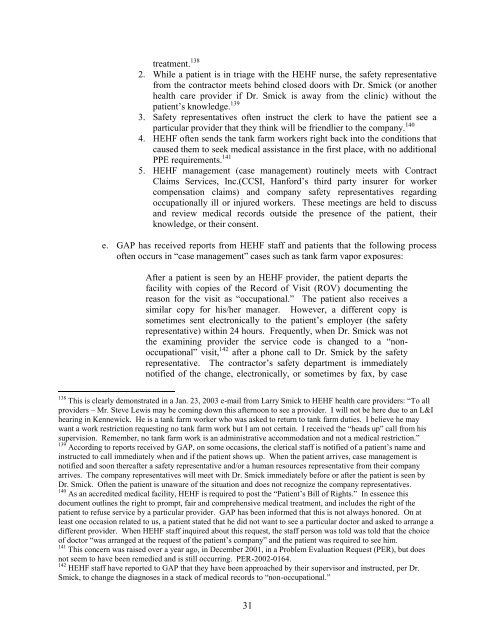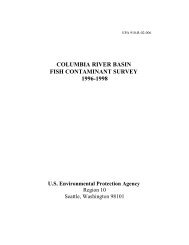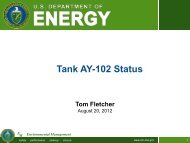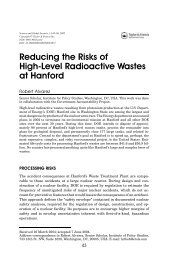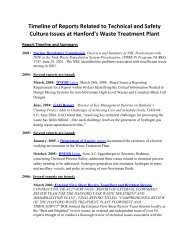Knowing Endangerment - Hanford Challenge
Knowing Endangerment - Hanford Challenge
Knowing Endangerment - Hanford Challenge
You also want an ePaper? Increase the reach of your titles
YUMPU automatically turns print PDFs into web optimized ePapers that Google loves.
treatment. 138<br />
2. While a patient is in triage with the HEHF nurse, the safety representative<br />
from the contractor meets behind closed doors with Dr. Smick (or another<br />
health care provider if Dr. Smick is away from the clinic) without the<br />
patient‟s knowledge. 139<br />
3. Safety representatives often instruct the clerk to have the patient see a<br />
particular provider that they think will be friendlier to the company. 140<br />
4. HEHF often sends the tank farm workers right back into the conditions that<br />
caused them to seek medical assistance in the first place, with no additional<br />
PPE requirements. 141<br />
5. HEHF management (case management) routinely meets with Contract<br />
Claims Services, Inc.(CCSI, <strong>Hanford</strong>‟s third party insurer for worker<br />
compensation claims) and company safety representatives regarding<br />
occupationally ill or injured workers. These meetings are held to discuss<br />
and review medical records outside the presence of the patient, their<br />
knowledge, or their consent.<br />
e. GAP has received reports from HEHF staff and patients that the following process<br />
often occurs in “case management” cases such as tank farm vapor exposures:<br />
After a patient is seen by an HEHF provider, the patient departs the<br />
facility with copies of the Record of Visit (ROV) documenting the<br />
reason for the visit as “occupational.” The patient also receives a<br />
similar copy for his/her manager. However, a different copy is<br />
sometimes sent electronically to the patient‟s employer (the safety<br />
representative) within 24 hours. Frequently, when Dr. Smick was not<br />
the examining provider the service code is changed to a “nonoccupational”<br />
visit, 142 after a phone call to Dr. Smick by the safety<br />
representative. The contractor‟s safety department is immediately<br />
notified of the change, electronically, or sometimes by fax, by case<br />
138 This is clearly demonstrated in a Jan. 23, 2003 e-mail from Larry Smick to HEHF health care providers: “To all<br />
providers – Mr. Steve Lewis may be coming down this afternoon to see a provider. I will not be here due to an L&I<br />
hearing in Kennewick. He is a tank farm worker who was asked to return to tank farm duties. I believe he may<br />
want a work restriction requesting no tank farm work but I am not certain. I received the “heads up” call from his<br />
supervision. Remember, no tank farm work is an administrative accommodation and not a medical restriction.”<br />
139 According to reports received by GAP, on some occasions, the clerical staff is notified of a patient‟s name and<br />
instructed to call immediately when and if the patient shows up. When the patient arrives, case management is<br />
notified and soon thereafter a safety representative and/or a human resources representative from their company<br />
arrives. The company representatives will meet with Dr. Smick immediately before or after the patient is seen by<br />
Dr. Smick. Often the patient is unaware of the situation and does not recognize the company representatives.<br />
140 As an accredited medical facility, HEHF is required to post the “Patient‟s Bill of Rights.” In essence this<br />
document outlines the right to prompt, fair and comprehensive medical treatment, and includes the right of the<br />
patient to refuse service by a particular provider. GAP has been informed that this is not always honored. On at<br />
least one occasion related to us, a patient stated that he did not want to see a particular doctor and asked to arrange a<br />
different provider. When HEHF staff inquired about this request, the staff person was told was told that the choice<br />
of doctor “was arranged at the request of the patient‟s company” and the patient was required to see him.<br />
141 This concern was raised over a year ago, in December 2001, in a Problem Evaluation Request (PER), but does<br />
not seem to have been remedied and is still occurring. PER-2002-0164.<br />
142 HEHF staff have reported to GAP that they have been approached by their supervisor and instructed, per Dr.<br />
Smick, to change the diagnoses in a stack of medical records to “non-occupational.”<br />
31


